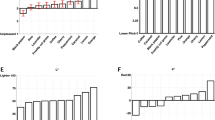Abstract
Two computer controlled experiments in an olfactory cross-modal matching task, using two-component odour mixtures matched against bar diagrams, were designed so that stimulus presentation was contingent upon the recent performance of the subject; stimuli that were relatively poorly (in experiment 1) or well (in experiment 2) matched were more frequently presented. Analysis shows that the autoregressive structure of the performance is modified by such contingent presentation and that there is a weak relationship between transmitted information in matching and the time series structure of the matching errors. It is suggested that the process is nonlinear.
Similar content being viewed by others
References
Appell, U., Brandt, A.V.: Adaptive sequential segmentation of piecewise stationary time series. Inf. Sci. 29, 27–56 (1983)
Bush, R.R., Mosteller, F.: Stochastic models for learning. New York: Wiley 1955
Gregson, R.A.M.: Representation of taste mixture cross-modal matching in a Minkowski r-metric. Aust. J. Psychol. 17, 195–204 (1965)
Gregson, R.A.M.: Theoretical and empirical multidimensional scalings of taste mixture matchings. Br. J. Math. Stat. Psychol. 19, 59–75 (1966)
Gregson, R.A.M.: Representation of a 2-input, 2-output odour mixture identification task as a multivariate time series. In: Proceedings of the 2nd Australian mathematical psychology conference. Newcastle, N.S.W.: University Press 1982
Gregson, R.A.M.: The sequential structure of odour mixture component intensity judgments. Br. J. Math. Stat. Psychol. 36, 132–144 (1983a)
Gregson, R.A.M.: Time series in psychology. New Jersey: L. Erlbaum 1983b
Gregson, R.A.M.: Invariance in the time series representations of 2-input, 2-output psychophysical experiments. Br. J. Math. Stat. Psychol. 37, 100–121 (1984a)
Gregson, R.A.M.: Invariance and heterogeneity in time series analyses of some psychophysical data. In: Time series analysis: theory and practice, Vol. 7. Amsterdam: North-Holland 1984b
Gregson, R.A.M.: Similarities between odor mixtures with known components. Percept. Psychophys. 35, 33–40 (1984c)
Marks, L.E.: Sensory processes, the new psychophysics. New York: Academic Press 1974
Martin, R.D.: Robust estimation for time series autoregressions. In: Robustness in statistics. Launer, R.L., Wilkinson, G.N. eds. New York: Academic Press 1979
Mood, A.M.: On the asymptotic efficiency of certain nonparametric two-sample tests. Ann. Math. Stat. 25, 514–522 (1954)
Patel, J.K., Kapadia, C.H., Owen, D.B.: Handbook of statistical distributions. New York: Dekker 1976
Thurstone, L.L.: A law of comparative judgment. Psychol. Rev. 34, 273–286 (1927)
Tong, H.: Theoretical models in non-linear time series analysis. Berlin, Heidelberg, New York: Springer 1983
Walsh, J.E.: Handbook of nonparametric statistics, Vol.II. New York: Van Nostrand 1965
Author information
Authors and Affiliations
Rights and permissions
About this article
Cite this article
Gregson, R.A.M., Gates, A. Cross-modal identification: Effects of contingent changes in the stimulus series. Biol. Cybern. 52, 247–258 (1985). https://doi.org/10.1007/BF00336981
Received:
Issue Date:
DOI: https://doi.org/10.1007/BF00336981




